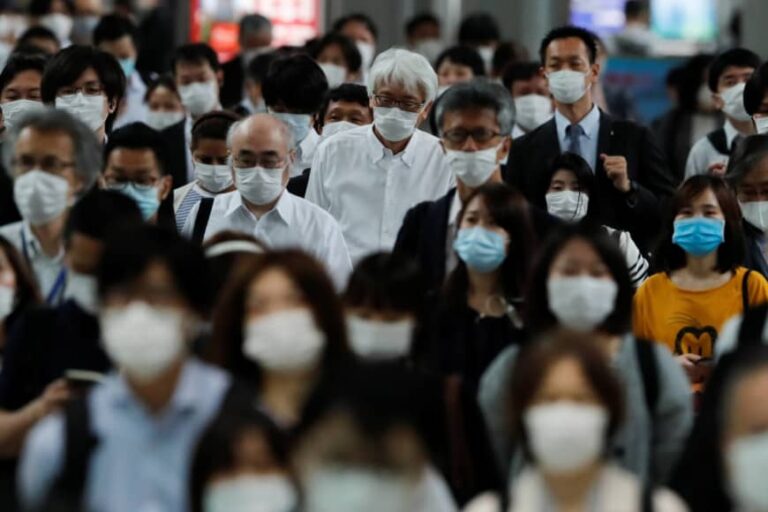
Mask-wearing — anathema to many in the U.S. — is one reason why Japan has avoided the heavy coronavirus death tolls seen in many parts of the world, according to the government’s expert panel on the pandemic.
While face-coverings have sparked angry confrontations in some parts of the world and were initially dismissed as ineffective by the World Health Organization, they have long been part of everyday life in Japan. But they won’t be enough for the country to maintain its strong record on containing the virus.
As of Wednesday, Japan had confirmed more than 16,000 infections and about 850 deaths from the virus, by far the lowest figures among the Group of Seven major economies. But in a reminder that the crisis is far from over, an uptick in cases in Kitakyushu this week sparked enough concern for the government to send a team to investigate, public broadcaster NHK said.
Even as the nation inches toward resuming activities, experts need to stamp out clusters faster than ever to fend off a more serious second wave of infections, according to written responses provided by the panel. That means a combination of PCR and antigen testing, and urging people to avoid risky situations.
Prime Minister Shinzo Abe ended the national state of emergency Monday, as cases had tailed off. He laid out plans for a gradual resumption of economic and social activities, in tandem with precautions against another major outbreak.
While Japan is currently held up as having dealt with COVID-19 relatively well, its health care system came close to collapse. There was no legally enforceable lock down, but social distancing caused severe economic pain, according to the comments provided via Mikihito Tanaka, an associate professor of journalism at Waseda University, who liaises with media for the panel.
The following is an edited translation of the panel’s responses to written questions:
The vice chairman of the expert panel, Shigeru Omi, has said that strong health consciousness among the Japanese helped keep the outbreak under control. What did he mean by health consciousness, and how does this differ from other countries?
There’s strong awareness of public hygiene, starting with the habit of washing our hands. And, due to historical experiences, there is widespread knowledge about preventing infections.
Another social factor is that Japanese people feel comfortable wearing masks on a daily basis. Many people are allergic to pollen, so they do this during the cedar pollen season from the beginning of the year until spring, as well as to protect against influenza.
What lessons have you learned for preventing a second wave?
Cluster surveillance has enabled us to ascertain what situations and places present a high risk. We have found out that wearing masks, hand hygiene, physical distancing and avoiding talking loudly are effective in preventing transmission.
A second wave is very possible, so we need to detect clusters faster than before. We also need to use the antigen testing we have developed, alongside PCR testing, to find cases before symptoms become serious.
Would you rate Japan’s virus policy as a success?
Japan’s health care system was on the brink of collapse, and we just barely managed to avoid that, thanks to an all-Japan effort. Even though we didn’t go as far as a lockdown like those seen in the U.S. and Europe, there has been great social and economic sacrifice. It’s difficult to find a balance between preventing the spread of the disease and social and economic activity.
Japan didn’t have a legal means of imposing a lockdown, but modeling showed that reducing social contacts by 80 percent would reduce infections, and many citizens cooperated. Of course, we weren’t 100 percent confident that everyone would comply, but we hoped and trusted that they would.
Do you have enough testing capacity? How much PCR and antibody testing is needed?
Japan’s initial policy was to test people when doctors considered it to be necessary. But the spread of the disease in mid-March meant that we weren’t able to provide testing for all citizens who needed it. PCR testing capacity didn’t expand fast enough to keep pace.
The absolute number of tests has been far lower than in other countries, but in fact the number of tests per reported death has been higher in Japan. In addition, the proportion of tests that yield a positive result was at one point more than 30 percent and has now fallen below 1 percent. It’s below 1 percent for the entire country, which is low compared with other nations, so we think the testing system is reasonable.
At this point, we are still not sure of the accuracy, especially in terms of sensitivity and specificity, of antibody tests. While we haven’t greatly misread the spread of the infection so far, in order to relieve the underlying anxiety of the Japanese people, we need to be able to carry out more antibody tests more quickly. It’s also important to have a communication system to listen to the views of the people.
not even a shred of scientific proof verifies any statement in this article. the masks used in the us range from bandanas to m95 and covid might get into a body through the eyes and the virus particulate is smaller than filters can keep out,
Comments are closed.